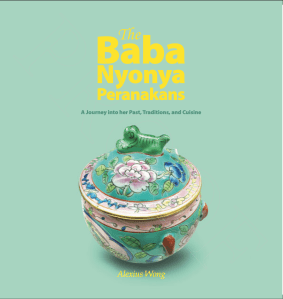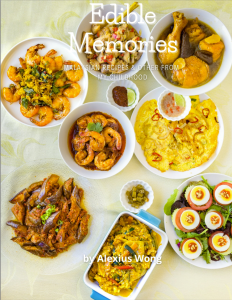
This recipe is basically Chinese in nature, mostly made up of Chinese ingredients that are not indigenous to Southeast Asia. However, the early Peranakan ancestors adapted this daily staple with the addition of local Southeast Asian spice ingredients such as dried shrimp, briny pungent belacan (shrimp paste), candlenuts, shallots, and red chilis—spices typically found in Nyonya dishes. This is also a popular dish in Medan, Sumatra, and Semarang, Java where the largest concentration of Indonesian Peranakans reside today. Surprisingly, I have found a non-spicy version of similar name in Korean restaurants, pointing to its Far East Asian roots.
The original name is Hokkien (Fujianese) for “mixed vegetables.” In this fairly simple dish you can taste the individual ingredients that complement each other: sweet cabbage, silky black or cloud fungus, woodsy lily bud, chewy tofu skin, and slippery bean thread noodles that have absorbed the rich sauce flavors. Most of the dried ingredients are imported from China and can be found in Oriental markets. Make sure to use the tender parts of the cabbage and to cut it into rather wide long ribbons so they do not disintegrate in this wonderfully satisfying and full-flavored vegetable dish.
A milder Chinese version was usually served in our household, especially during special occasions (Chinese New Year in particular due to its vegetarian nature) and birthdays. However, this Peranakan version is equally delectable with its spicier, more pungent flavors and was usually present at our everyday dinners. My father recalls eating this dish often as a child, prepared by his mother. My maternal grandmother usually cooked the milder version, since she grew up in a Cantonese environment before her arranged marriage to a Baba Peranakan from the Malacca region. The addition of stronger tropical flavor elements to the Chinese recipe is indicative of the fusion of Chinese and Southeast Asian culinary traditions, a true reflection of Nyonya food itself.
A recent recreation of this dish was a mind-opening revelation for me. For the longest time my memory of this dish was very sketchy, and I had a difficult time recalling the flavors. When I took the first bite of my attempt to recreate it, a stream of nostalgia rushed in with the recollection of the familiar flavors, and a comforting feeling of family, especially my paternal grandmother, Mamah. I remembered with sorrow that the last time I had savored this bowl of “lost memory” was when she passed away more than thirty years before. Just like the Bi Tai Bak and Spicy Chicken Gizzard and Pork Salad recipes, this dish could have easily slipped into oblivion, taking away with it a nugget of memory of my growing up as a Peranakan. But now, I cherish this recipe with a certain sense of zeal, knowing that not only is it a wonderfully delectable dish but also one that was saved and brought back into my consciousness and culinary repertoire.
Recipe from The Baba Nyonya Peranakans book
Serves 4
Preparation time: 30 minutes
Cooking time: 15 minutes
⅔ cup dried black or cloud fungus
2 tablespoons dried shrimp, soaked in water for 10 minutes, drained
6 grams/½ teaspoon belacan (shrimp paste)
3 candlenuts, shelled and crushed, or cashew or macadamia nuts (optional)
5 small (50 grams/1¾ ounces) shallot, peeled
4 cloves garlic, chopped fine (1 tablespoon minced)
2 Finger Hot red chili peppers, stemmed and seeded, or 1 teaspoon paste/sambal oelek
4 tablespoons vegetable oil
½ cup dried lily bud (Cantonese: kim chan), soaked, hard tip removed, and tied into a knot
1 piece curled tofu skin (Cantonese: foo chook), rinsed until pliable and cut into 5-centimeter (2-inch) pieces
4 cups white cabbage, ribs removed if tough, cut into 1-inch (2.5-centimeter) wide by 4-inch (10- centimeter) long strips
1 cup water
1 teaspoon thin soy sauce
¾ teaspoon salt
1 handful bean thread or glass noodles, soaked in cold water until soft, drained
- Soak the dried black/cloud fungus and lily bud separately in hot water for 30 minutes. While waiting, prepare the rest of the ingredients. When the fungus is finished soaking and is soft, divide each cluster into bite-size pieces and discard any hard pieces. With the lily bud, pinch off the hard end, and tie into a knot.
- In a food processor, pulse the soaked dried shrimp until quite fine. Remove and set aside.
- To the processor, add the belacan, candlenuts, shallots, garlic and chilis, and purée into a fine paste. Remove, mix with the dried shrimp, and set aside.
- In a pan on medium-high heat, heat the oil. Fry the spice paste and dried shrimp until aromatic, 2 to 3 minutes. Add the fungus, lily bud, and tofu skin, and stir for 1 minute. Add the cabbage, breaking it into loose leaves. Add the water, soy sauce, and salt. Cover with a lid and bring to a simmer.
- When the sauce is simmering, remove the lid and cook until the cabbage is tender but not too soft, about 5 minutes. When cooked, add the bean thread noodles to the sauce and stir for 10 seconds only. Taste and adjust the seasoning. Serve immediately.


The hardcopy and e-book of The Baba Nyonya Peranakans book (1st image) and Edible Memories e-cookbook (2nd image) are available – more information on the Homepage.

Have always had Cantonese chap chai but not the peranakan version. Will definitely try this recipe.
LikeLike
Thank you for comment. You will taste the Nyonya touch to this Chinese classic, and hopefully you will enjoy the spicy and strong flavors.
LikeLike
The amount of ingredients required frightens me. One of my Peranakan friend is a very good cook, and he once told me that a good chap chai has to have at least 10 ingredients, and you certainly have that and more. However, I recently made the Chinese chap chai for a family member, and so have some of the ingredients already. You make this recipe so interesting, with the background notes and family stories, that it makes me want to do it. Thank you once again Alexius.
LikeLike
Thank you Anne. I hope my story inspired you to go beyond your trepidation of the recipe and give it a try. I think you will enjoy it.
LikeLike
I will certainly try your spicy version.Alternatively,you can have sambal belachan at the side and make the mild version.
LikeLike
Yes indeed. Both versions are equally scrumptious.
LikeLike
I always thought that all Nonya versions start out with a saute of garlic paste ( fresh pounded garlic ) followed by taucheo but your recipe does not use taucheo
LikeLike
Yes, as I wrote in the blog, my family had two versions of this dish, and the dish was the spicier version. However, we enjoyed both of them equally. Maybe you would like this version when you try it.
LikeLike